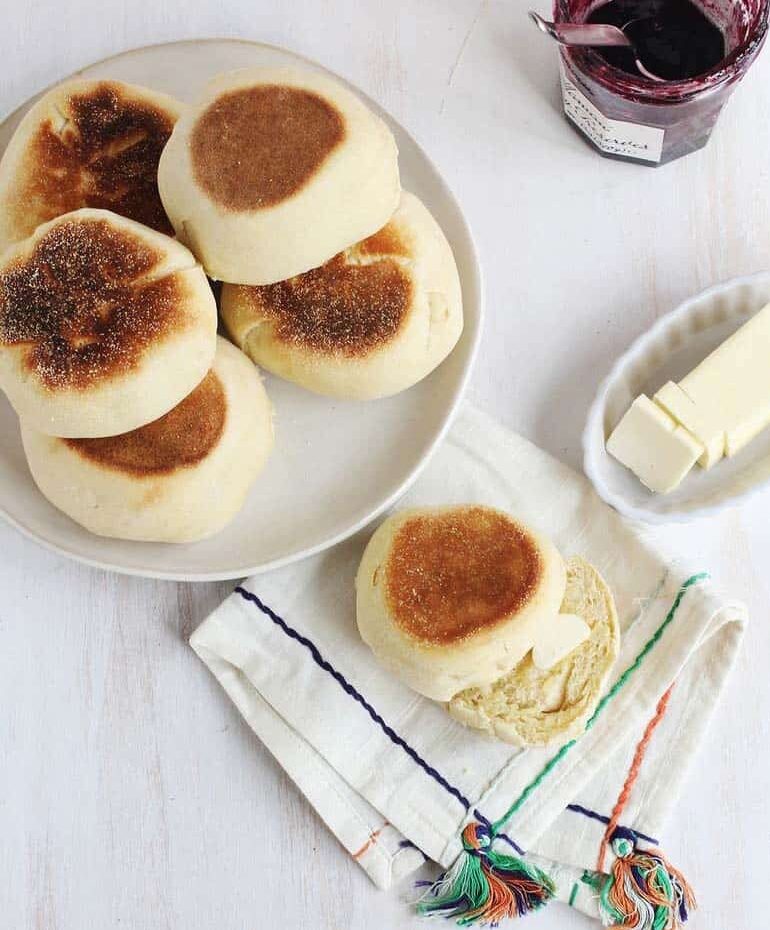Comprehensive English Muffin Recipe Guide
The Ultimate Guide to Making Perfect Homemade English Muffins
English Muffins are the ultimate breakfast bread—soft, chewy, and full of those signature nooks and crannies. Whether you spread them with butter, add jam, or transform them into a classic Eggs Benedict, homemade English muffins are a game-changer compared to store-bought. In this guide, we’ll walk you through all the steps needed to create delicious English muffins, along with essential tips to help you perfect them every time.
If you’re looking for a simple, foolproof way to make these at home, then you’re in the right place! Making English muffins doesn’t require you to be a professional baker—just follow this guide, and you’ll be serving up fresh, warm muffins that’ll impress everyone.
Why Make Homemade English Muffins?
- Freshness and Flavor: Store-bought muffins can’t compare to the taste of fresh, homemade muffins. You can control the ingredients, ensure no preservatives, and enjoy them at their peak flavor.
- Healthier: With simple ingredients like all-purpose flour, butter, and whole milk, you can make healthier muffins without any unnecessary additives. They’re also customizable—swap out dairy for non-dairy alternatives, or use organic ingredients for a healthier twist.
- Versatile: English muffins aren’t just for breakfast. They’re perfect for sandwiches, snacks, or even mini pizzas. Toast them for a crispy texture, or enjoy them as a soft, chewy bread—either way, they’ll taste incredible.
Key Ingredients and Substitutions
- All-Purpose Flour: It’s all you need for this recipe—no need to hunt down specialty bread flour. The result is a soft, tender muffin with a chewy texture.
- Butter: Melted butter is essential for flavor and creating those signature nooks and crannies. If you prefer, you can substitute it with plant-based butter for a dairy-free option.
- Yeast: You can use either active dry or instant yeast. If you opt for active dry yeast, it will need to be activated in warm milk and water before mixing with the other ingredients.
- Milk: Whole milk is ideal as it adds richness and moisture. However, low-fat milk or even plant-based milk (like almond or oat milk) will work if you’re looking for a dairy-free version.
- Sugar: A small amount of sugar helps activate the yeast and adds a subtle sweetness. Avoid brown sugar, as it changes the flavor profile.
- Salt: Essential for seasoning and enhancing the dough’s flavor.
- Semolina or Cornmeal: Used to dust the muffins before cooking, this prevents sticking and gives them a crisp exterior.
Step-by-Step Instructions
- Activate the Yeast: Begin by combining warm milk, water, and sugar in a small bowl. The temperature should be around 110°F to activate the yeast properly. Add the yeast and let it sit for about 5-7 minutes, until it becomes foamy. This step is crucial, as it ensures that the yeast is alive and ready to help the dough rise.
- Mix the Dough: In a stand mixer, combine the flour and salt. Slowly add the yeast mixture along with a beaten egg and melted butter. Use the dough hook attachment and mix at medium speed for about 7 minutes until the dough becomes smooth and elastic. If you don’t have a stand mixer, you can knead the dough by hand, though it will be a bit sticky.
- First Rise: Transfer the dough to a large, oiled bowl. Cover it with plastic wrap and allow it to rise in a warm, draft-free spot for about 1 hour, or until doubled in size. For a more flavorful dough, you can refrigerate it overnight and let it warm to room temperature before shaping.
- Shape the Muffins: After the dough has risen, transfer it to a floured surface. Gently press it down to about ¾ inch thickness. Use a 3-inch round cutter to cut out the muffins. If you don’t have a round cutter, shape the dough into rounds by hand.
- Second Rise: Place the cut muffins on a baking sheet lined with parchment paper and sprinkled with semolina or cornmeal. Cover loosely with plastic wrap and allow them to rise for another 30 minutes.
- Cook the Muffins: Preheat a large skillet or griddle over low heat. Sprinkle the surface with cornmeal or semolina and cook the muffins for 5-6 minutes on each side. They should be golden brown on the outside and cooked through. If needed, bake them in a 350°F oven for 3 minutes if they’re too soft in the middle.
Tips and Tricks for Success
- Longer Proofing Time: While 1 hour is sufficient for proofing, letting the dough rise for 4-8 hours will give it a deeper flavor.
- Use a Stand Mixer: This dough can be sticky, so using a stand mixer helps with kneading. If kneading by hand, flour your work surface generously.
- Perfect Cooking Temperature: Low heat is key. If the heat is too high, the muffins will burn on the outside before the inside cooks fully.
- Make-Ahead Option: You can refrigerate the dough overnight for a more relaxed preparation. Simply let it sit at room temperature for about 1 hour before proceeding with shaping.
- Storing: Cooked muffins keep well in an airtight container for 3-5 days. To freeze, wrap individually and store for up to 3 months. Just toast them when ready to eat.
Quick English Muffin Recipe
Description
Soft, chewy, and filled with nooks and crannies, these English muffins are perfect for breakfast or brunch. Enjoy them with butter, jam, or as the base for Eggs Benedict.
Calories: 132kcal | Carbohydrates: 22g | Protein: 4g | Fat: 3g | Saturated Fat: 2g | Trans Fat: 1g | Cholesterol: 8mg | Sodium: 195mg | Potassium: 63mg | Fiber: 1g | Sugar: 2g | Vitamin A: 96IU | Vitamin C: 1mg | Calcium: 20mg | Iron: 1mg



